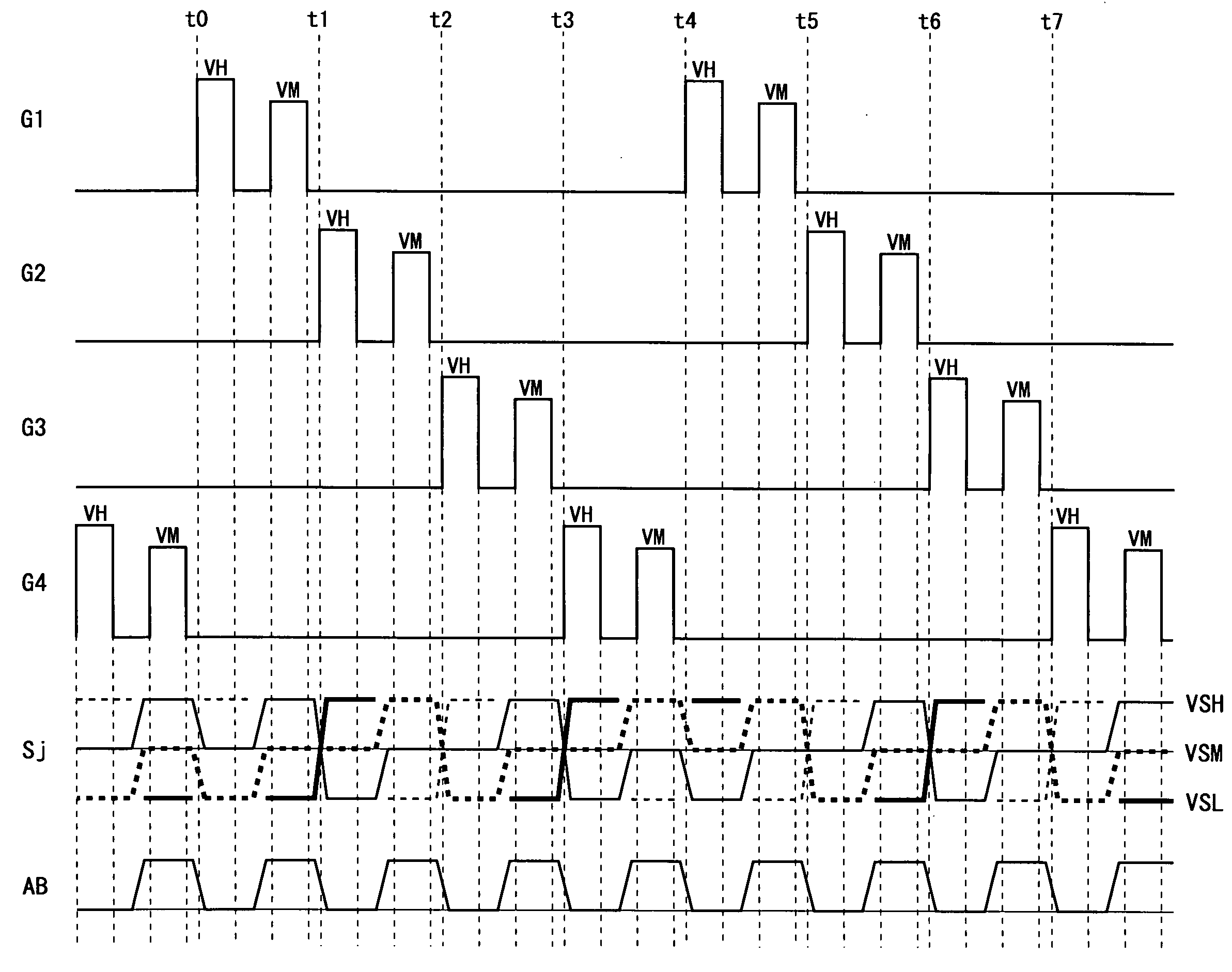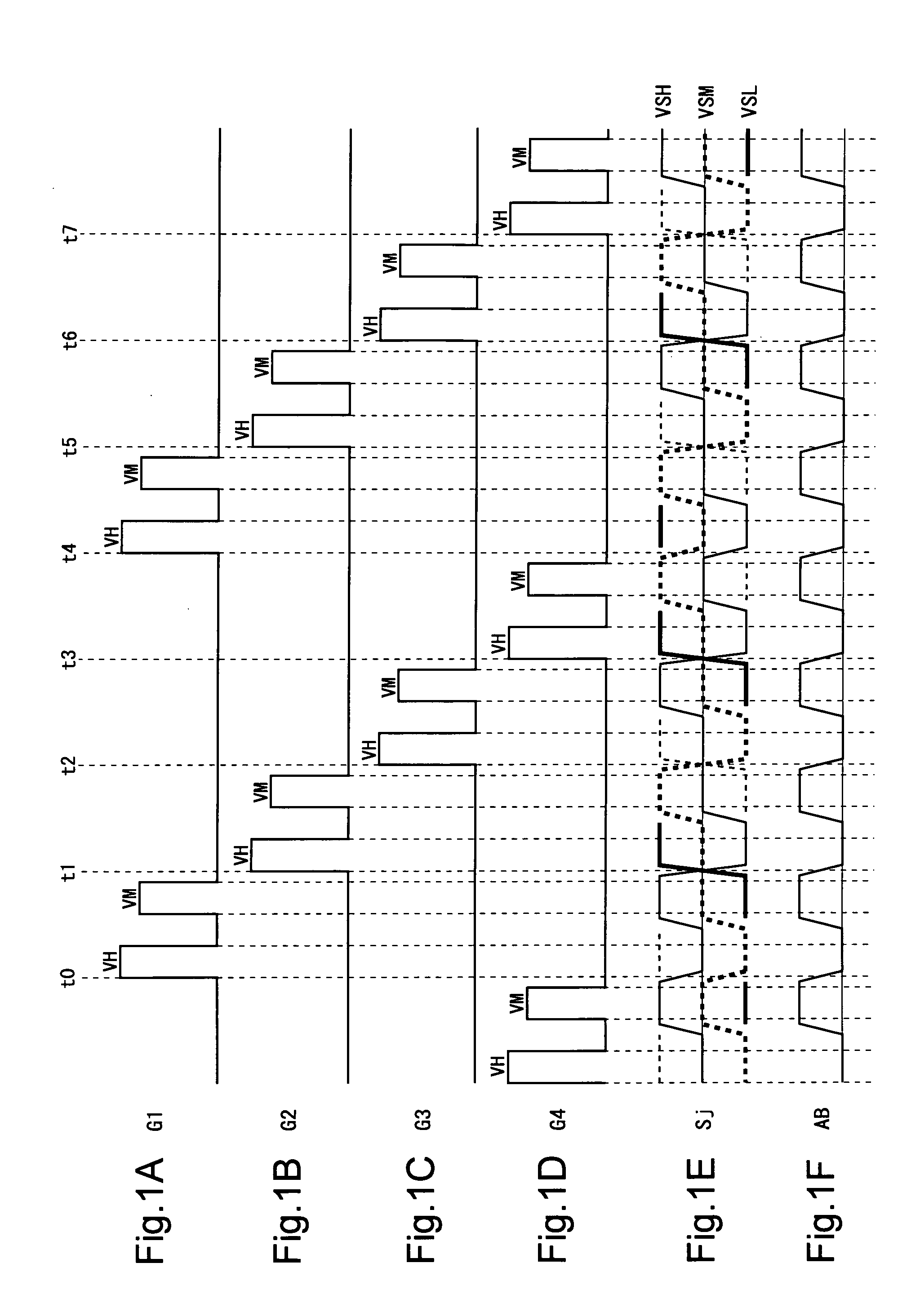Display device,it's driving circuit, and driving method
a technology of pixel electrode and driving circuit, applied in the field of pixel electrode, can solve the problems of increasing the cost of the semiconductors as the voltage of the pixel electrode increases, and achieve the effects of reducing power consumption, reducing the amplitude of the voltage, and efficiently increasing the voltage of the pixel electrod
- Summary
- Abstract
- Description
- Claims
- Application Information
AI Technical Summary
Benefits of technology
Problems solved by technology
Method used
Image
Examples
first embodiment
2. First Embodiment
2.1 Overall Configuration and Operation
[0132]FIG. 2 is a block diagram illustrating the overall configuration of a liquid crystal display device according to a first embodiment of the present invention. The liquid crystal display device includes a display control circuit 100, a display portion 200, a source driver (video signal line drive circuit) 300, a gate driver (scanning signal line drive circuit) 400, and an auxiliary capacitance driver (auxiliary capacitance electrode drive circuit) 500. Hereinafter, the source driver 300, the gate driver 400, and the auxiliary capacitance driver 500 may also be collectively referred to as a driver (drive circuit). FIG. 3 is a block diagram illustrating detailed configurations of the drivers and the display portion 200 in the liquid crystal display device. Note that the liquid crystal display device performs a 64-tone gradation display.
[0133]The display portion 200 includes n source lines (video signal lines) S1 to Sn, m ga...
second embodiment
3. Second Embodiment
[0181]FIG. 15 is a block diagram illustrating configurations of drivers and a display portion 200 in a liquid crystal display device according to a second embodiment of the present invention. In the present embodiment, unlike in the first embodiment, all auxiliary capacitance lines Ck are electrically connected to the common electrode 24. Accordingly, no auxiliary capacitance driver 500 is provided.
[0182]FIGS. 16A to 16D are signal waveform diagrams describing a drive method in the present embodiment. In the present embodiment, since all auxiliary capacitance lines Ck are electrically connected to the common electrode 24, as described above, the voltage of the common electrode 24 and the voltages of the auxiliary capacitance lines Ck change in the same manner, as shown in FIG. 16C. Note that as in the first embodiment, the waveform of the selection signal applied to the gate line G1, the waveform of the drive video signal applied to the source line Sj, and the wa...
third embodiment
4. Third Embodiment
[0197]FIG. 17 is a block diagram illustrating configurations of drivers and a display portion 200 in a liquid crystal display device according to a third embodiment of the present invention. In the present embodiment, the auxiliary capacitance lines are divided into four groups. Note that, in the example shown in FIG. 17, there are four auxiliary capacitance lines, and therefore each group includes only one auxiliary capacitance line, but in the case where there are, for example, 240 auxiliary capacitance lines, each group includes 60 auxiliary capacitance lines. In the present embodiment, when grouping the auxiliary capacitance lines, they are initially divided into overlying groups and underlying groups with respect to the center of the display portion 200, and further divided into groups of odd-numbered rows and even-numbered rows. For example, when there are 240 auxiliary capacitance lines, the auxiliary capacitance lines in the “first row, third row, fifth ro...
PUM
 Login to View More
Login to View More Abstract
Description
Claims
Application Information
 Login to View More
Login to View More - R&D
- Intellectual Property
- Life Sciences
- Materials
- Tech Scout
- Unparalleled Data Quality
- Higher Quality Content
- 60% Fewer Hallucinations
Browse by: Latest US Patents, China's latest patents, Technical Efficacy Thesaurus, Application Domain, Technology Topic, Popular Technical Reports.
© 2025 PatSnap. All rights reserved.Legal|Privacy policy|Modern Slavery Act Transparency Statement|Sitemap|About US| Contact US: help@patsnap.com



